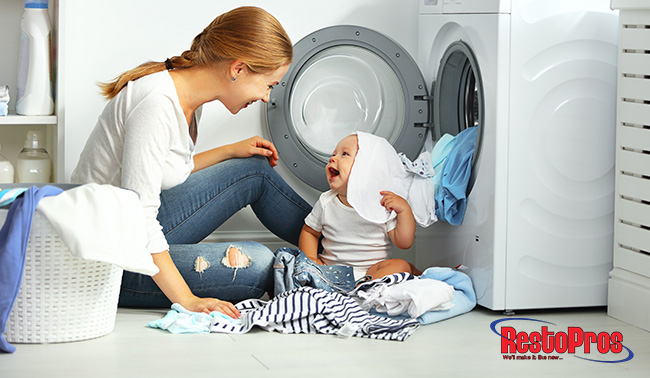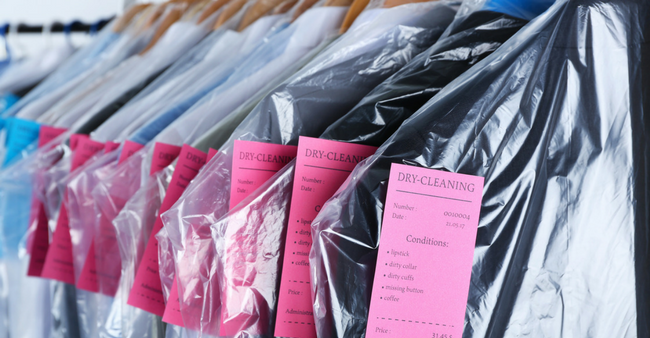
The humid Dallas summer guarantees that most people who to leave their home during the day will return with damp clothing. Just a few minutes in a hot car can drench someone in sweat during a hot afternoon. This can lead to problems for people who leave clothing in a stuffed hamper for several days. Any fabric that is left wet or damp for more than 24 hours can easily develop mold growth. The humid Texas air can also exacerbate a mold problem in clothes, especially if your home has a humidity level over 50 percent. Last week we shared tips on getting rid of mold odor in clothing and accessories. This week we’re looking at tackling mold itself, which is even trickier to get off fabric once it has started to grow. Mold can destroy clothing, so the sooner that you act on getting rid of it the better.
Washing out the Mold
If you find mold in your clothing, don’t wait to treat it! Basic cotton t-shirts, shirts, pants, socks and underwear are the easiest to tackle. First, wear plastic gloves and remove the clothing from the home. Take a sponge or old wash cloth and remove as much of the mold growth off the material as you can. Bring the clothes back inside and separate the lights and darks as you normally would for a regular wash. Bleach is one of the oldest remedies for mold removal – and works well on certain items (including cotton clothing). Do a load of laundry using hot water and your regular detergent. Once the washing machine has filled up with water, then add a cup of bleach. Color-safe bleach is also an option, though it might not work as well in certain instances. Whenever you are washing mold out of clothing, it is most effective to wash them through two complete cycles.
Bleach does not work for all materials – and can stain or fade certain pieces. A popular alternative for fighting mold is white distilled vinegar. (Vinegar can kill 82% of mold species.) It is especially effective in treating cotton blends, linen and polyester. Pouring a cup of vinegar into the wash will help rid most clothing of mold. But be mindful of the care directions for bright clothing and “hand wash only” pieces. Other ingredients used for getting rid of mold are borax, lemon juice – or a combination of baking soda and hydrogen peroxide. Make sure run the clothes through two full cycles. Again, these remedies are most effective in the early stages of mold infestation. If the mold has started breaking down the fabric and eating through it, it’s best to throw the piece away.
After you have washed your clothes, you will want to dry them immediately. The ideal drying method would be hanging the clothing outside on a clothesline. The sunlight is ideal for treating and eradicating mold as well.

Dry Clean Only
Most people own a few pieces of clothing that are “dry clean only.” If you own garments that are contaminated by mold and can’t be washed at home – send them out immediately. The heat used in the dry cleaning process is an effective way to rid fabric of mold as well. If you have other pieces of contaminated clothing that proved difficult to clean, you might consider sending them to the dry cleaners. This is the most expensive solution, but necessary for some materials – especially for silk and complicated blends.
Summer Mold Strategy
It’s not always possible to wash your damp clothing immediately. In the heat of the summer especially, your clothes are going to experience some kind of sweat-related dampness. The best way to combat mold growth is to line dry any clothing that gets damp before throwing it into the hamper. Even laying clothing out overnight and letting it air dry will help keep mold from appearing on material. The key here is to be proactive, which is sometimes difficult after coming home from the sweltering heat. Always dry damp clothing that is destined for the clothes hamper and avoid destructive mold growth.
Dangers of Mold
Sometimes mold can start growing on clothing without any obvious signs. An undetectable mold spore outbreak is just as hazardous as one that is visible. Breathing in spores can cause allergic reactions including sinus problems, runny eyes and skin rashes. Mold in your clothing can also contaminate the air; affecting the indoor air quality and even spurring growth in other areas of the home. Be mindful of the summer heat and the state of your clothing once you come home. By taking a few precautions with sweaty materials, you should be able to successfully bypass mold contamination.
RestoPros is the DFW leader in mold damage restoration and remediation. If you have any problems with mold in your home, don’t hesitate to give us a call. Our trained and licensed technicians can assess your problem and offer safe, effective solutions for recovery. Call 855-587-3786 to schedule an appointment today!
Related Blogs:
Healthy Humidity Levels in the Summer
5 Natural Cleaning Methods for Small Mold Spots
Don’t forget to follow RestoPros on Facebook, Twitter, LinkedIn, and Google+ for new Updates, News, and Discounts.
